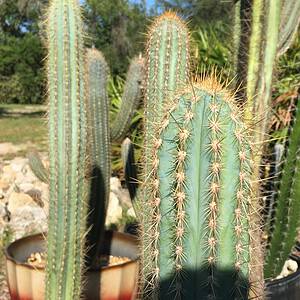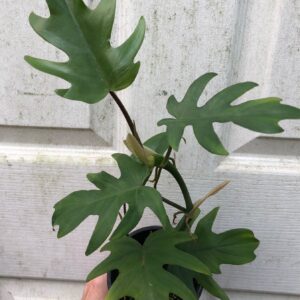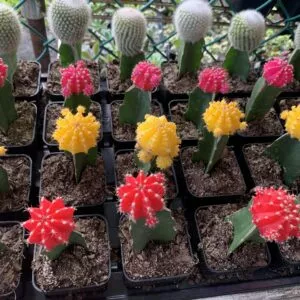No products in the cart.
You need not wait to enjoy blazing fall colors in your garden. No, with the Japanese maple, you get fiery autumn hues, and the tree has deeply dissected leaves.
But there is another maple tree that makes a statement the Red Dragon Japanese maple. The tree has a pink to plum color all season long.
When spring arrives, the tree bursts into a bright ruby red to display a vibrant color. Most Japanese maples grow well in a landscape to even containers for Bonsai art.
Today we look at this fantastic maple tree and how you can care for them.
Botanical Name: Acer palmatum var. dissectum ‘Red Dragon’
Other Name: ‘Red Dragon’ Japanese maple, laceleaf maple, laceleaf weeping maple
Native Area: Cultivar
Plant Type: Deciduous Tree
Growth: 10 Feet Tall and 10 Feet Wide
Fertilizer: Rarely Needed
Light Requirement: Partial
Propagation: Grafting or softwood cuttings
Soil Type: Loamy, acidic soil
Temperature: Dry, warm temperatures
Toxicity: Toxic to Pets When Leaves Consumed
Watering: Roots need to remain moist
USDA Zones: 5-8
More About Japanese Maples
Out of the Japanese Maple trees (Acer palmatum), the Red Dragon Japanese Maple cultivar (Acer palmatum var dissectum Red Dragon) is the most variegated of them. It is a slow-growing tree bred in New Zealand.
Hence, it makes for ideal landscape interest in a small yard near a patio or a rock garden. You can also grow them as Bonsai in containers. The Red Dragon, Japanese Maple foliage, displays fern-like lacy leaves hence the name laceleaf maple.
In early spring, the foliage starts with a cherry color and becomes darker towards summer. Then the foliage turns scarlet in the fall, giving it a pink to-plum tint. The low height of the weeping branches with spreading habit looks more like a shrub than a tree.
After dropping its leaves, it remains an eye-catching specimen with a twisted trunk. Yet, as the tree becomes mature, the trunk becomes gnarlier. Another notable thing about the Red Dragon Japanese Maple is the shallow root system it grows.
Red Dragon Japanese Maple Care
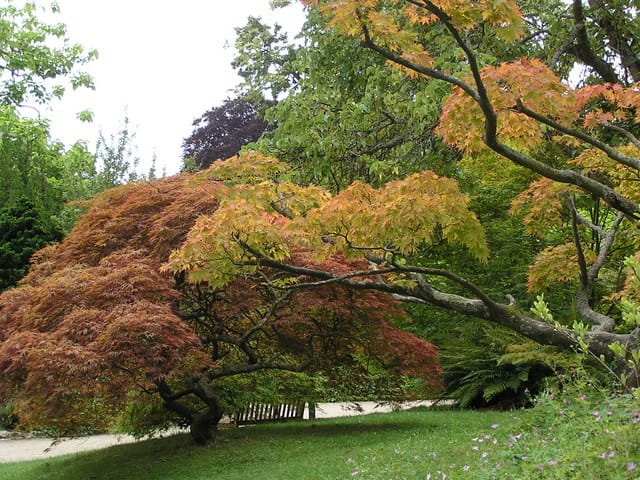
With the cascading branches to the ground and colorful foliage, the Red Dragon Maple tree becomes a focal point in the garden. Still, most Japanese Maples can take up to eight years or longer to reach a mature size.
It would be best to spread the roots to prevent circular growth when you plant young trees. Hence, it helps to spread the roots outwards to prevent strangling each other. The tree is a slow grower; part of the charm is allowing nature to take its course when you do not prune them.
Another important thing to remember is not to plant your tree close to a black walnut as it exudes juglone. The chemical is very toxic, killing other plants. While the Red Dragon Japanese Maple is more tolerant than other plants, it can lead to stunted growth.
The Best Spot in The Garden

Whether you grow your Red Dragon as a dwarf tree or in landscaping, it needs up to six hours of direct sunlight. When you live in the USDA zone 5 to 8, your tree can grow in full sun without burning.
In zone 9, your Red Dragon Japanese Maple is sun tolerant in the morning but needs afternoon shade. Standing in full sun all day leads to the foliage becoming burned and crispy. The opposite happens when grown in full shade. Growing fewer branches, they become sick and die.
The only time the Red Dragon Japanese Maples need full shade is after planting, but only when done in the heat 🔥 of summer. Then, when fall arrives, you need to remove the shade. Lastly, planted in dappled light without direct sunlight, the foliage looks greenish-red.
The Right Garden Soil For Japanese Maple Tree
When you plant your tree, provide it with loose, well-draining soil with a lot of organic matter added, like compost. Stagnant water can lead to root rot for the Red Dragon. Neither should water collect at the soil surface near your planting side.
The soil needs to be slightly acidic, around 6.2 to 6.5, as your Japanese maple cannot tolerate alkaline soil. With a soil test kit, you can quickly test the pH level to adjust it accordingly. If the soil is above 7.0, we recommend adding a soil acidified.
The best is to dig a hole twice the size of the root ball and fill the bottom with up to two buckets of organic compost mixed with the native soil. Then, add the acidifier if needed and place the tree in the hole with the root ball at the surface level.
Another important thing is to not bury the trunk and water heavily after planting.
Watering Dragon Japanese Maple Trees
You must water your trees when the top two inches of the soil are dry. You can use one gallon of water when watering your Red Dragon tree. The more mature your tree becomes you can expect to provide up to two gallons or more.
We recommend not letting the soil dry out more than an inch for newly planted trees in the first year. The Red Dragon Japanese Maple takes up to two years to become established. When this happens, you can refrain from watering.
Still, if you want to grow a tree with success having a healthy tree keep checking the soil moisture, nonetheless, it does depend on the weather if it rains or not. Your potted Red Dragon will need water regularly.
Never allow the soil to dry out; provide your tree with drainage holes allowing the water to run out and not stagnate at the bottom.
Fertilizer For a Healthy Plant
At planting young trees and adding compost, your tree will not need any fertilizer. The best time to fertilize is in spring using a balanced slow-release fertilizer. Also, look for a product containing iron and magnesium.
You only need to fertilize once a year to prevent over-fertilizing. Alternatively, you can use organic compost by mulching the soil. Still, prevent making the layer more than two inches and place it a few inches away from the trunk.
Adding mulch helps retain moisture and protects the roots.
Temperature and Humidity
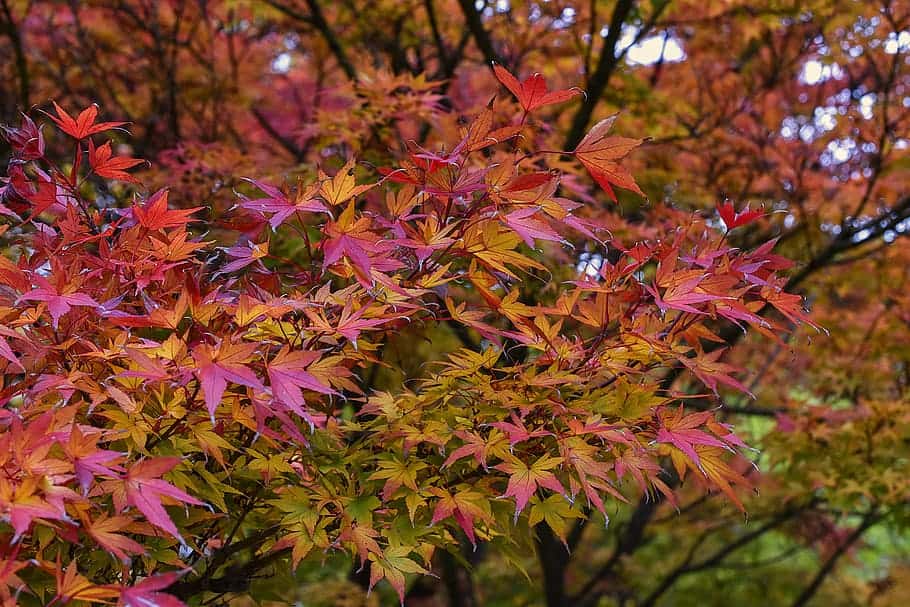
The Red Dragon Japanese maple tree can withstand moderate humidity but does not do well with a temperature above 90°F. In weather with hot, dry winds, it tends to damage the leaves, scorching them.
The tree can also leaf out early standing in hot climates damaging the young leaves as late frost arrives. During winter, the chilly winds can damage the leaves, and best to keep them away from windy locations for protection.
So the rule is to protect it from direct sun in hot temperatures and provide it with partial shade, especially in the afternoon. As mentioned, do not plant your tree in a cooler climate in dappled shade without sun, as it can lead to stunted growth.
Pruning Japanese Maple Trees
For heavy snowfall, we recommend removing it to prevent the branches from breaking. Heavy pruning needs to be done in the dormancy period of winter. If you want to shape your tree, do this in early spring once leaves emerge.
You can prune the dead branches and disinfect your garden tools before using them. Also, do not remove more than one-fourth of the crown to prevent stress; the same applies when pruning branches.
When you climb up your Dragon Japanese maple removing the lower branches, only remove a few limbs.
Potting and Repotting Red Dragon Japanese Maple
The Red Dragon Japanese maple is a compact tree that grows slowly. Hence, you can plant it in a container to train as a Bonsai tree. Still, be aware of too much heat and sun. Your tree will need more watering and well-drained soil.
Ensure that your Red Dragon grows in a container twice the size of the rootball. We recommend using terra cotta pots as it wicks out the extra moisture. Once the roots poke out the side or the bottom, which takes a few years, you can repot your tree.
Overwintering Your Japanese Maple
Your Japanese maple can tolerate temperatures down to -15°F. Still, container plants and your young trees will need protection. Also, do not fertilize past mid-summer; try to do this in early summer instead.
The fertilizer will result in new growth at the end of summer, and it is vulnerable to the cold. Give your tree a lot of water before the first frost arrives, especially with little rain present. Add some mulch, and we recommend wrapping your tree with burlap if you have heavy snowfall.
Do this for the first three winter seasons to protect the roots. Afterward, containers can be taken into an unheated garage or the basement to overwinter. At this time, your tree needs no light, like during growing seasons, as it is dormant.
Keep the soil moist but not waterlogged, as frequent watering is unnecessary.
Propagating Red Dragon Japanese Maple
The Red Dragon can propagate from grafting or taking softwood stem cuttings. The best time to do this is mid-spring after new growth starts.
Stem Cutting
Use a sharp, sterilized knife to cut 8 inches of new growth from a softwood stem. Choose one that has hardened and cut one with some leaves on end.
Remove the rest of the leaves and only keep the ones closer to the tip.
Prepare a container with equal parts coarse sand, perlite, peat moss, and water well, allowing it to drain.
Optional place the cut end into rooting hormone and place in the moist, well-drained soil.
Moisten again, but do not oversaturate it, and place it in bright indirect light.
Mist your cutting twice a day until the root system develops, which can take up to four weeks.
Grafting Red Dragon Japanese Maple
Grafting is best done in winter as you need to join the rootstock of another closely related variety with the scion of your cultivar. To do this, choose a 2-year-old seedling with a trunk of at least 1/8 inch in diameter.
Take your base plant to remove it from dormancy for a month, placing it in a warm spot with morning sun and partial shade.
Use a sharp grafting knife and cut a long diagonal splice about an inch long. Cut a cutting in the same diameter from your cultivar plant to fit the two together.
Take rubber grafting tape to secure the graft, and use grafting wax.
Then place your tree in a location with the sun but not direct sunlight with some shade.
Check the wax in about five days to retain a good seal and keep the humidity high.
When you notice new growth on the rootstock, prune it away. But check for new growth from the scion as it means the graft took.
Once the scion develops new leaves, you can remove the wrapping to prevent girdling.
After a year of successful growth, you can plant your tree in the ground. Growing your tree from seeds is not always true to the parent plant, so we do not recommend using this method.
Japanese Maple Comparison
There are quite a few Japanese maple varieties you can grow. But today, we want to compare some of them with the Red Dragon.
Red Dragon Japanese Maple vs. Bloodgood Japanese Maple

The difference between the two Japanese maple trees is the leaf shape. The Red Dragon has red leaves with leaves dissected up to seven lobes and dissections looking like lacy leaves.
While the Bloodgood leaves also have a leaf split, the lobes are not split, making the foliage of the Red Dragon more attractive. The Bloodgood is a larger species reaching up to 25 feet tall, with the Red Dragon only ten feet.
Another advantage the Red Dragon has is it can grow in zone 9, as the Bogwood cannot survive well in hot climates.
Inaba Shidare Japanese Maple vs. Red Dragon Japanese Maple
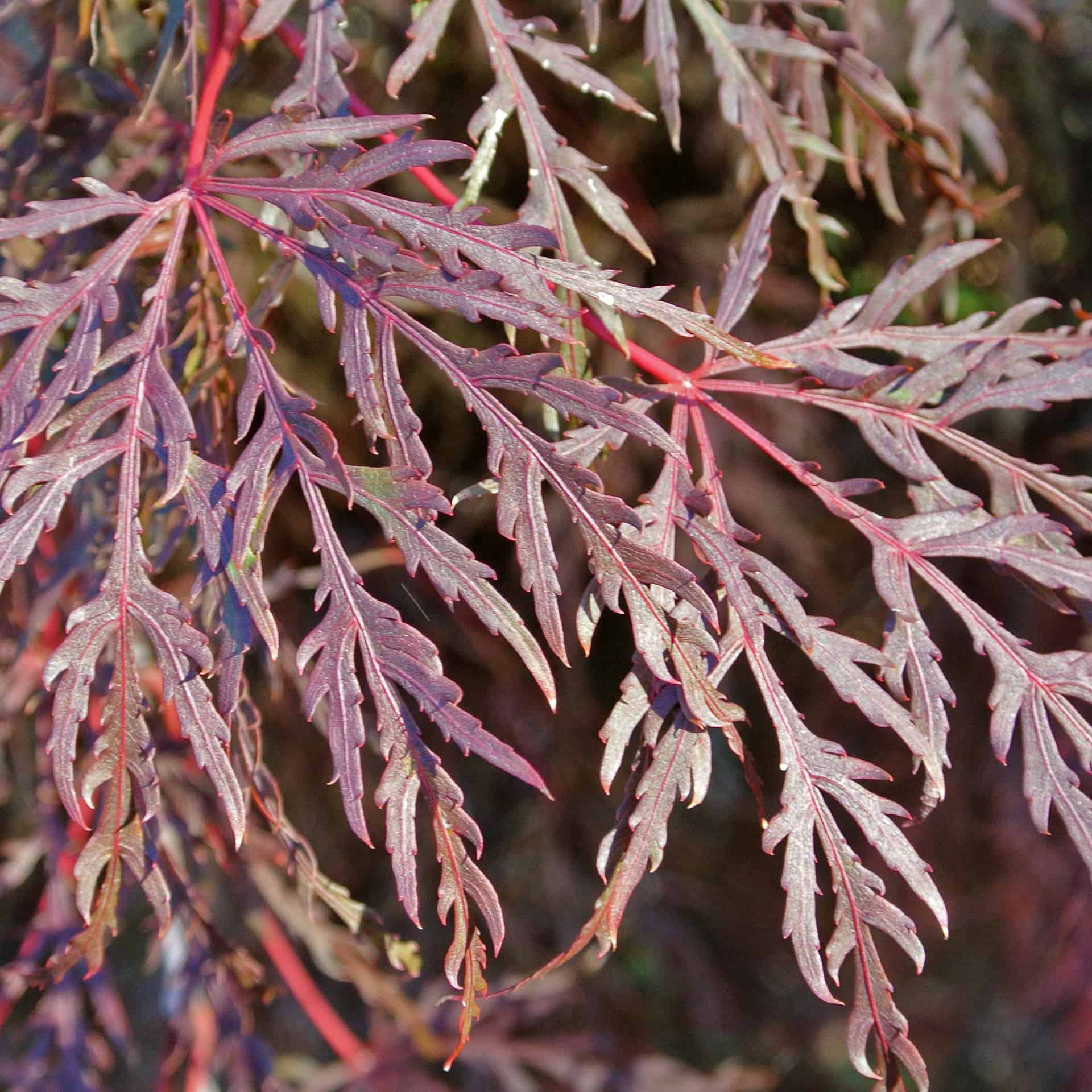
Here the difference is notable in the crown of the maple trees. Inaba Shidare can grow up to eight feet tall, with a width of ten feet, forming an umbrella. The Red Dragon forms a mound when growing.
The Red Dragon has bright red leaves all season long, with the Inaba Shidare having burgundy to purple leaves. The two maples have a similar spread with weeping growth and deeply dissected leaves. Both these specimens tolerate full sunlight well to partial shade.
Most Common Pests and Diseases
The Red Dragon Japanese maples are susceptible to different fungal diseases like:
Stem Canker
Leaf Spots
Verticillium Wilt
Anthracnose
Botrytis
Fusarium Wilt
Root Rot
With proper care, these fungal diseases are quickly resolved. To prevent this from happening, do annual pruning to remove dying and dead branches from leaves. Also, replace the mulch annually. Then spray your trees with a multipurpose fungicide to treat them. Provide air circulation and avoid overwatering your trees.
Common pests are the Japanese beetle feeding on the leaves from time to time. Other insects are aphids, scale bugs, mealybugs, and mites to borers. You can use strong insecticidal soap or Neem oil to control them.
Frequently Asked Questions
One problem you can find with your trees is leaf spots to leaf drops. These are signs of a fungal infection or even a Japanese beetle infection. You can use insecticidal soap or horticultural oil to eliminate insects.
If anthracnose or leaf spot to bacterial tip blights are present, you may need to remove your tree to prevent the spread of infection. Other common concerns are leaf growing, or twigs dying from underwatering and reversed with watering profoundly and regularly.
Root collar cankers, verticillium, or wounds cause wilting leaves. The nematodes feed on the root system in the soil, providing openings for the fungus to spread and resulting from overwatering.
The Red Dragon and other Japanese maple trees can live up to 100 years. The trees grow about one foot per year for the first 50 years.
The Red Dragon has rich dark red foliage retaining the color throughout the year compared to the Crimson Queen with brownish red leaves.
Red Dragons prefer the full-shade weather and tolerate frost but need protection against cold winds and dry winters. Growing at 6-8 feet (240 cm) tall. It can also be planted in a dry, moist organically rich, lightly acidic, well-drained area.
The red dragon Japanese maple is a slow growing dwarf variety that matures at 4-8 feet tall and wide. In ideal conditions, expect around 6 to 12 inches of new growth per year once established. With proper care, this petite maple will reach its full size within 5-10 years after planting. The compact dimensions and red foliage make it perfect for small gardens or containers.
Whether you want to buy, sell, or simply reach out to other plant enthusiasts, Plantly is the right place to be!
Whether you want to buy, sell, or simply reach out to other plant enthusiasts, Plantly is the right place to be!
-
$17.95Sold By: Orchid Stuff Plus
$23.95In stock
Stunning Snake Plant Sansevieria Zeylanica in a 6 inch pot!
Only 2 available and it’s in 1 people’s basketRated 5.00 out of 5 based on 1 customer rating00Sold By: Orchid Stuff Plus -
-
$25.95Sold By: SunSoul Plants
$42.95In stock
Philodendron Mayoi Plant in 4″ pot, philodendron Tahiti
Rated 4.87 out of 5 based on 98 customer ratings00Sold By: SunSoul Plants -
$29.99Sold By: BubbleBlooms
In stock
Grafted Moon Cactus / Ruby Ball Cactus Set of 4 different colors
Rated 4.81 out of 5 based on 279 customer ratings00Sold By: BubbleBlooms

